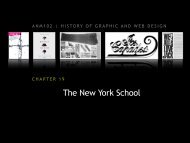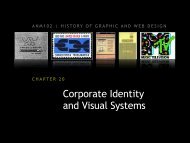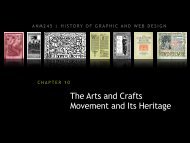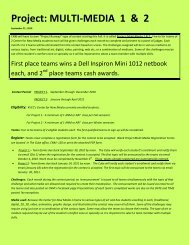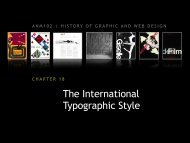A Graphic Renaissance PDF - ANM102 History of Graphic and Web ...
A Graphic Renaissance PDF - ANM102 History of Graphic and Web ...
A Graphic Renaissance PDF - ANM102 History of Graphic and Web ...
Create successful ePaper yourself
Turn your PDF publications into a flip-book with our unique Google optimized e-Paper software.
PART TWOChapters 5–8HISTORY OF GRAPHIC & WEB DESIGN1
PART TWOChapters 5–8HISTORY OF GRAPHIC & WEB DESIGNA <strong>Graphic</strong> <strong>Renaissance</strong>1
CHAPTER FIVEPrinting comes to EuropeHISTORY OF GRAPHIC & WEB DESIGN`2
CHAPTER FIVEPrinting comes to EuropeHISTORY OF GRAPHIC & WEB DESIGNThe dem<strong>and</strong> for books became insatiablewith an emerging literate middle class <strong>and</strong>students attending university.But even a simple two-hundred page bookrequired four to five months labor by ascribe <strong>and</strong>/or illustrator, <strong>and</strong> at least 25sheepskins were needed for theparchment pages alone.The value <strong>of</strong> single book may be equal tothe value <strong>of</strong> a farm or vineyard.3
CHAPTER FIVEPrinting comes to EuropeHISTORY OF GRAPHIC & WEB DESIGN4
CHAPTER FIVEPrinting comes to EuropeHISTORY OF GRAPHIC & WEB DESIGNFrom China to Europe, the development<strong>of</strong> paper made from rags <strong>and</strong> otherplant materials revolutionized the waybooks were made <strong>and</strong> paved the wayfor modern printing technology.4
CHAPTER FIVEPrinting comes to EuropeHISTORY OF GRAPHIC & WEB DESIGNFrom China to Europe, the development<strong>of</strong> paper made from rags <strong>and</strong> otherplant materials revolutionized the waybooks were made <strong>and</strong> paved the wayfor modern printing technology.Prior to the invention <strong>of</strong> the printingpress in the mid 1400’s, woodblockprinting on paper was popular in Asia<strong>and</strong> Europe. Playing cards <strong>and</strong> religiousimages were early evidence <strong>of</strong> this newtechnology.4
CHAPTER FIVEPrinting comes to EuropeHISTORY OF GRAPHIC & WEB DESIGN5
CHAPTER FIVEPrinting comes to EuropeHISTORY OF GRAPHIC & WEB DESIGNIn addition to playing cards, the earlyEuropean images were devotional prints <strong>of</strong>saints. Images <strong>and</strong> lettering were both cutfrom the same block <strong>of</strong> wood.5
CHAPTER FIVEPrinting comes to EuropeHISTORY OF GRAPHIC & WEB DESIGNIn addition to playing cards, the earlyEuropean images were devotional prints <strong>of</strong>saints. Images <strong>and</strong> lettering were both cutfrom the same block <strong>of</strong> wood.Eventually, these prints evolved into blockbooks which were picture books withreligious themes <strong>and</strong> brief text. Again,each page was cut from a single block <strong>of</strong>wood <strong>and</strong> were primarily used for religiousinstruction <strong>of</strong> illiterates.5
CHAPTER FIVEPrinting Comes to EuropeHISTORY OF GRAPHIC & WEB DESIGN6
CHAPTER FIVEPrinting Comes to EuropeHISTORY OF GRAPHIC & WEB DESIGNMost <strong>of</strong> these prints were h<strong>and</strong> colored,but most were printed with a h<strong>and</strong> rubberroller (brayer) <strong>and</strong> brown or gray ink. Butthis rubber roller impressed the wood intothe paper making double-sided printing notan option. Each double-page spread wasfollowed by two blank pages.Color was added by using stencils.http://www.youtube.com/watch?v=mgCYovlFRNY6
CHAPTER FIVEPrinting Comes to EuropeHISTORY OF GRAPHIC & WEB DESIGN7
CHAPTER FIVEPrinting Comes to EuropeHISTORY OF GRAPHIC & WEB DESIGNWith the availability <strong>of</strong> paper <strong>and</strong> agrowing dem<strong>and</strong> for books, themechanization <strong>of</strong> book production wassought by printers all over Europe.<strong>History</strong> notes that Johann Gutenberg,<strong>of</strong> Germany was the first to create aprocess for printing books using a winepress as a foundation.7
CHAPTER FIVEPrinting Comes to EuropeHISTORY OF GRAPHIC & WEB DESIGN8
CHAPTER FIVEPrinting Comes to EuropeHISTORY OF GRAPHIC & WEB DESIGNBut with the invention <strong>of</strong> the printing presscame a need for a different type <strong>of</strong> ink thatwould stick to metal type, a smootherpaper, <strong>and</strong> most <strong>of</strong> all, a method forcreating movable type <strong>and</strong> a system foraligning all the type on a page.8
CHAPTER FIVEPrinting Comes to EuropeHISTORY OF GRAPHIC & WEB DESIGN9
CHAPTER FIVEPrinting Comes to EuropeHISTORY OF GRAPHIC & WEB DESIGNGutenberg needed as many as 50,000single pieces <strong>of</strong> type in use at a singletime, so the speed <strong>and</strong> accuracy <strong>of</strong> settingtype in a mold was key.9
CHAPTER FIVEPrinting Comes to EuropeHISTORY OF GRAPHIC & WEB DESIGN10
CHAPTER FIVEHISTORY OF GRAPHIC & WEB DESIGNPrinting Comes to EuropeThe first printed typographic book,attributed to Gutenberg, but actuallyfinished by a financial partner, JohannFust, was called the 42-line GutenbergBible.10
CHAPTER FIVEPrinting Comes to EuropeHISTORY OF GRAPHIC & WEB DESIGN11
CHAPTER FIVEPrinting Comes to EuropeHISTORY OF GRAPHIC & WEB DESIGNWith lines <strong>of</strong> about 33 characters, each pagehad over 2,500 characters set from a font <strong>of</strong>290 different characters.11
CHAPTER FIVEPrinting Comes to EuropeHISTORY OF GRAPHIC & WEB DESIGN12
CHAPTER FIVEPrinting Comes to EuropeHISTORY OF GRAPHIC & WEB DESIGNIn addition to the Gutenberg Bible, JohannFust <strong>and</strong> his business partner, <strong>and</strong> formerassistant to Gutenberg, Peter Schoeffer,published a book <strong>of</strong> biblical psalms called apsalter.12
CHAPTER FIVEPrinting Comes to EuropeHISTORY OF GRAPHIC & WEB DESIGNIn addition to the Gutenberg Bible, JohannFust <strong>and</strong> his business partner, <strong>and</strong> formerassistant to Gutenberg, Peter Schoeffer,published a book <strong>of</strong> biblical psalms called apsalter.This psalter introduced two-color initialcaps <strong>and</strong> was the first book to bear aprinter’s tradmark <strong>and</strong> date <strong>of</strong> publicationcalled a colophon. Colophons arecommonly found today at the end <strong>of</strong> aprinted novel or other book.12
CHAPTER FIVEPrinting Comes to EuropeHISTORY OF GRAPHIC & WEB DESIGN13
CHAPTER FIVEPrinting Comes to EuropeHISTORY OF GRAPHIC & WEB DESIGNDuring the same time, copperplateengraving was popular. It involvedscratching an image into a smooth metalplate, applying ink into the depressions,wiping the surface clean <strong>and</strong> pressing paperagainst the plate to receive the image.13
CHAPTER FIVEPrinting Comes to EuropeHISTORY OF GRAPHIC & WEB DESIGNDuring the same time, copperplateengraving was popular. It involvedscratching an image into a smooth metalplate, applying ink into the depressions,wiping the surface clean <strong>and</strong> pressing paperagainst the plate to receive the image.An extraordinary amount <strong>of</strong> detail could beachieved with this process.13
CHAPTER FIVEPrinting Comes to EuropeHISTORY OF GRAPHIC & WEB DESIGN20
CHAPTER FIVEPrinting Comes to EuropeHISTORY OF GRAPHIC & WEB DESIGNCopperplate engraving continued to grow in popularityas technical refinements greatly increased its range <strong>of</strong>tone, texture, <strong>and</strong> detail. In addition to commissioningengravings for placement in printed books, studiosbegan producing them to hang on a wall. This enabledpeople who were unable to afford oil paintings, theopportunity to purchase art.The nature <strong>of</strong> engraving—scratching fine lines into metal—encouraged the development <strong>of</strong> script letterforms withextremely delicate lines.20
CHAPTER SIXThe German Illustrated BookHISTORY OF GRAPHIC & WEB DESIGN14
CHAPTER SIXThe German Illustrated BookHISTORY OF GRAPHIC & WEB DESIGNThe Latin word incunabula, meaning “cradle”was adopted as a way to describe the veryrare books that were published in the early1500s. Gutenberg’s mechanized invention setinto motion over the next three hundred years,a process that would lead to the IndustrialRevolution in the 18 <strong>and</strong> 1900s.14
CHAPTER SIXThe German Illustrated BookHISTORY OF GRAPHIC & WEB DESIGNThe Latin word incunabula, meaning “cradle”was adopted as a way to describe the veryrare books that were published in the early1500s. Gutenberg’s mechanized invention setinto motion over the next three hundred years,a process that would lead to the IndustrialRevolution in the 18 <strong>and</strong> 1900s.A printed ex libris, or bookplate, was pastedinto the front <strong>of</strong> a book to identify its owner.14
CHAPTER FIVEThe German Illustrated BookHISTORY OF GRAPHIC & WEB DESIGN15
CHAPTER FIVEThe German Illustrated BookHISTORY OF GRAPHIC & WEB DESIGNIn Germany, woodcut artists <strong>and</strong>typographic printers collaborated to developillustrated books <strong>and</strong> broadsheets. One earlytypographic book by Albrecht Pfister, wasillustrated with woodblock prints, similar tothe earlier process used for playing cards<strong>and</strong> woodblock books. Over the decades,printers increased their use <strong>of</strong> woodblockillustrations <strong>and</strong> ultimately created abooming dem<strong>and</strong> for blocks, <strong>and</strong> along withit, a growing dem<strong>and</strong> for graphic illustrators.15
CHAPTER SIXThe German Illustrated BookHISTORY OF GRAPHIC & WEB DESIGN16
CHAPTER SIXThe German Illustrated BookHISTORY OF GRAPHIC & WEB DESIGNMany <strong>of</strong> these illustrations were notcompletely enclosed with a border,allowing for more white space to flowfrom the wide margins <strong>of</strong> the pages.One <strong>of</strong> the first travel books to beprinted was illustrated by ErhardReuwich who introducedcrosshatching <strong>and</strong> fold-out pages.This illustration/map depicts thetravels <strong>of</strong> a German nobleman throughthe Holy L<strong>and</strong>.16
CHAPTER SIXThe German Illustrated BookHISTORY OF GRAPHIC & WEB DESIGN17
CHAPTER SIXThe German Illustrated BookHISTORY OF GRAPHIC & WEB DESIGNAlbrect Dürer was perhaps the most prolific<strong>and</strong> respected illustrators in the early 1500s.His extraordinarily detailed woodcuts werevery popular <strong>and</strong> led him to become a majorinfluence in bringing the <strong>Renaissance</strong> spirit<strong>and</strong> philosophy to Germany.17
CHAPTER SIXThe German Illustrated BookHISTORY OF GRAPHIC & WEB DESIGN18
CHAPTER SIXThe German Illustrated BookHISTORY OF GRAPHIC & WEB DESIGNHis illustration entitled Rhinoceroswas reprinted in eight separateeditions over the next three hundredyears. While highly detailed, theimage contained many anatomicinaccuracies, but nonethelessbecame one <strong>of</strong> the most notable<strong>and</strong> historically significantillustrations <strong>and</strong> thus had a pr<strong>of</strong>oundinfluence on the arts.18
CHAPTER SIXThe German Illustrated BookHISTORY OF GRAPHIC & WEB DESIGN18
CHAPTER SIXThe German Illustrated BookHISTORY OF GRAPHIC & WEB DESIGNRhinoceros was created as abroadside—a single piece <strong>of</strong> paperprinted on one side. Festivals wereadvertised, lottery tickets sold,political causes <strong>and</strong> religious beliefswere proclaimed—all because <strong>of</strong>the large <strong>and</strong> visually arrestingprinted images. When both sideswere printed it was called abroadsheet. Broadsides were theprecursor to posters, which are stillvery popular today.18
CHAPTER SIXThe German Illustrated BookHISTORY OF GRAPHIC & WEB DESIGN19
CHAPTER SIXThe German Illustrated BookHISTORY OF GRAPHIC & WEB DESIGNThroughout the 15 <strong>and</strong> 1600s, Germangraphic design continued to showcaseblackletter typography <strong>and</strong> woodcutillustrations. The typeface Textura, notedbecause <strong>of</strong> its dense visual “texture” wasfavored throughout Germany. Today, thistypeface style has strong connotativeassociations with religious holidays, gothicthemes, <strong>and</strong> oddly, tattoos.19
CHAPTER SIXThe German Illustrated BookHISTORY OF GRAPHIC & WEB DESIGNThroughout the 15 <strong>and</strong> 1600s, Germangraphic design continued to showcaseblackletter typography <strong>and</strong> woodcutillustrations. The typeface Textura, notedbecause <strong>of</strong> its dense visual “texture” wasfavored throughout Germany. Today, thistypeface style has strong connotativeassociations with religious holidays, gothicthemes, <strong>and</strong> oddly, tattoos.19
CHAPTER SEVEN<strong>Renaissance</strong> <strong>Graphic</strong> DesignHISTORY OF GRAPHIC & WEB DESIGN20
CHAPTER SEVEN<strong>Renaissance</strong> <strong>Graphic</strong> DesignHISTORY OF GRAPHIC & WEB DESIGNThe word <strong>Renaissance</strong> means “revival” or “rebirth.” Originally this termwas used to denote the period between the 14th <strong>and</strong> 15th centuries in Italy,but today the word is generally used to describe the period marking thetransition from medieval to the modern world.Type design, page layout, ornamentation, illustration <strong>and</strong> even complete bookdesign were reconsidered by Italian printers <strong>and</strong> scholars. <strong>Graphic</strong> design,the arts, music, literature, music—all flourished during the <strong>Renaissance</strong> <strong>and</strong>some <strong>of</strong> our greatest masters lived <strong>and</strong> created during this time.20
CHAPTER SEVEN<strong>Renaissance</strong> <strong>Graphic</strong> DesignHISTORY OF GRAPHIC & WEB DESIGN20
CHAPTER SEVEN<strong>Renaissance</strong> <strong>Graphic</strong> DesignHISTORY OF GRAPHIC & WEB DESIGNVenice, Italy, the center <strong>of</strong> commerce<strong>and</strong> trade between Europe <strong>and</strong> otherEastern Mediterranean nations, led theway in Italian typographic book design.Nicholas Jensen is noted as one <strong>of</strong>history’s greatest typeface designers.Throughout his career, he designed<strong>and</strong> published 150 books as well asoutst<strong>and</strong>ing Greek <strong>and</strong> Gothic fonts.20
CHAPTER SEVEN<strong>Renaissance</strong> <strong>Graphic</strong> DesignHISTORY OF GRAPHIC & WEB DESIGNVenice, Italy, the center <strong>of</strong> commerce<strong>and</strong> trade between Europe <strong>and</strong> otherEastern Mediterranean nations, led theway in Italian typographic book design.Nicholas Jensen is noted as one <strong>of</strong>history’s greatest typeface designers.Throughout his career, he designed<strong>and</strong> published 150 books as well asoutst<strong>and</strong>ing Greek <strong>and</strong> Gothic fonts.Jensen, as well as other early printersdesigned trademarks to identify theirbooks, leading the way to logo designas an art form.http://typography timeline.html20
CHAPTER SEVEN<strong>Renaissance</strong> <strong>Graphic</strong> DesignHISTORY OF GRAPHIC & WEB DESIGN20
CHAPTER SEVEN<strong>Renaissance</strong> <strong>Graphic</strong> DesignHISTORY OF GRAPHIC & WEB DESIGNJenson’s fonts were extremely legible<strong>and</strong> his attention to the space betweenthe letters <strong>and</strong> within each letterform setthe pace for type designers today, <strong>and</strong>placed the mark <strong>of</strong> genius on his work.20
CHAPTER SEVEN<strong>Renaissance</strong> <strong>Graphic</strong> DesignHISTORY OF GRAPHIC & WEB DESIGNJenson’s fonts were extremely legible<strong>and</strong> his attention to the space betweenthe letters <strong>and</strong> within each letterform setthe pace for type designers today, <strong>and</strong>placed the mark <strong>of</strong> genius on his work.The modern version <strong>of</strong> Jenson’s typefaceis used frequently by designers today.Its thick <strong>and</strong> thin strokes, <strong>and</strong> bracketedserifs make it a highly legible faceappropriate for reading large bodies<strong>of</strong> text.20
CHAPTER SEVEN<strong>Renaissance</strong> <strong>Graphic</strong> DesignHISTORY OF GRAPHIC & WEB DESIGN20
CHAPTER SEVEN<strong>Renaissance</strong> <strong>Graphic</strong> DesignHISTORY OF GRAPHIC & WEB DESIGN<strong>Renaissance</strong> designers loved floraldecoration in furniture, architecture, aswell as printed manuscripts. This designaesthetic carried over into book designwith a collaboration betweenthe typographic printer <strong>and</strong>the illuminator who added initials<strong>and</strong> embellishments to the page.20
CHAPTER SEVEN<strong>Renaissance</strong> <strong>Graphic</strong> DesignHISTORY OF GRAPHIC & WEB DESIGN<strong>Renaissance</strong> designers loved floraldecoration in furniture, architecture, aswell as printed manuscripts. This designaesthetic carried over into book designwith a collaboration betweenthe typographic printer <strong>and</strong>the illuminator who added initials<strong>and</strong> embellishments to the page.20
CHAPTER SEVEN<strong>Renaissance</strong> <strong>Graphic</strong> DesignHISTORY OF GRAPHIC & WEB DESIGN20
CHAPTER SEVEN<strong>Renaissance</strong> <strong>Graphic</strong> DesignHISTORY OF GRAPHIC & WEB DESIGNDuring the early 1500s, a turning away from medieval beliefs toward a newconcern for human potential <strong>and</strong> value, characterized <strong>Renaissance</strong> humanism—a philosophy <strong>of</strong> human dignity <strong>and</strong> worth that defined man as capable <strong>of</strong>using reason <strong>and</strong> scientific inquiry to achieve both an underst<strong>and</strong>ing <strong>of</strong> theworld <strong>and</strong> self-meaning. This new spirit was accompanied by a renewedstudy <strong>of</strong> classical writings from Greek <strong>and</strong> Roman cultures.20
CHAPTER SEVEN<strong>Renaissance</strong> <strong>Graphic</strong> DesignHISTORY OF GRAPHIC & WEB DESIGNDuring the early 1500s, a turning away from medieval beliefs toward a newconcern for human potential <strong>and</strong> value, characterized <strong>Renaissance</strong> humanism—a philosophy <strong>of</strong> human dignity <strong>and</strong> worth that defined man as capable <strong>of</strong>using reason <strong>and</strong> scientific inquiry to achieve both an underst<strong>and</strong>ing <strong>of</strong> theworld <strong>and</strong> self-meaning. This new spirit was accompanied by a renewedstudy <strong>of</strong> classical writings from Greek <strong>and</strong> Roman cultures.One such notable humanist <strong>and</strong> scholar was Aldus Manutiuswho established a printing press in Venice called the AldinePress. His vision <strong>of</strong> publishing the major works <strong>of</strong> the greatthinkers <strong>of</strong> the world became a reality through his dedication<strong>and</strong> hard work.20
CHAPTER SEVEN<strong>Renaissance</strong> <strong>Graphic</strong> DesignHISTORY OF GRAPHIC & WEB DESIGN20
CHAPTER SEVEN<strong>Renaissance</strong> <strong>Graphic</strong> DesignHISTORY OF GRAPHIC & WEB DESIGNManutius addressed a growing needfor smaller, more economical booksby publishing the first prototype <strong>of</strong>the pocket book. This first edition <strong>of</strong>Vergils’ Opera was only 3.75 x 5inches <strong>and</strong> contained the first italictypeface.20
CHAPTER SEVEN<strong>Renaissance</strong> <strong>Graphic</strong> DesignHISTORY OF GRAPHIC & WEB DESIGN20
CHAPTER SEVEN<strong>Renaissance</strong> <strong>Graphic</strong> DesignHISTORY OF GRAPHIC & WEB DESIGNThe brilliant designer <strong>of</strong> the italic typeface was aman named Francesco da Bologna, surnamedGriffo. His style survives today as the book textface Bembo <strong>and</strong> is widely used by modern-daygraphic designers. His elongated ascenders <strong>and</strong>descenders resulted a lighter look to page layout,especially combined with generous margins, finerpaper <strong>and</strong> meticulous presswork.20
CHAPTER SEVEN<strong>Renaissance</strong> <strong>Graphic</strong> DesignHISTORY OF GRAPHIC & WEB DESIGNThe brilliant designer <strong>of</strong> the italic typeface was aman named Francesco da Bologna, surnamedGriffo. His style survives today as the book textface Bembo <strong>and</strong> is widely used by modern-daygraphic designers. His elongated ascenders <strong>and</strong>descenders resulted a lighter look to page layout,especially combined with generous margins, finerpaper <strong>and</strong> meticulous presswork.Griffo typefaces became themodel for French type designerswho perfected his letterformsduring the following century.http://bemboszoo.com/20
CHAPTER SEVEN<strong>Renaissance</strong> <strong>Graphic</strong> DesignHISTORY OF GRAPHIC & WEB DESIGN20
CHAPTER SEVEN<strong>Renaissance</strong> <strong>Graphic</strong> DesignHISTORY OF GRAPHIC & WEB DESIGNThe typographic book came to Italy from Germany as a manuscript-style bookprinted with type. A series <strong>of</strong> design innovations, including the title page, roman<strong>and</strong> italic type, printed page numbers, woodblock <strong>and</strong> cast metal ornaments,<strong>and</strong> innovative approaches to the layout <strong>of</strong> illustrations with type, enabled theItalian printers <strong>of</strong> the <strong>Renaissance</strong> to pass on to posterity the basic format <strong>of</strong>the typographic book as we know it today.20
CHAPTER SEVEN<strong>Renaissance</strong> <strong>Graphic</strong> DesignHISTORY OF GRAPHIC & WEB DESIGN20
CHAPTER SEVEN<strong>Renaissance</strong> <strong>Graphic</strong> DesignHISTORY OF GRAPHIC & WEB DESIGNThe Italian <strong>Renaissance</strong> began to fade after the sack <strong>of</strong> Rome in 1527 by the HolyRoman Emperor Charles V <strong>and</strong> his Spanish allies.The sixteenth century has become known as “the golden age <strong>of</strong> French Typography.”The leading printers produced books <strong>of</strong> fine proportions, outst<strong>and</strong>ing legibility, beautifultypography, <strong>and</strong> elegant ornamentation.Two brilliant graphic artists, Ge<strong>of</strong>frey Tory<strong>and</strong> the typeface designer Claude Garamondcreated visual forms that were reproducedfor over two hundred years. In fact, theGaramond typeface is one <strong>of</strong> the mostwidely used text font used by designers today.http://garamond timeline20
CHAPTER SEVEN<strong>Renaissance</strong> <strong>Graphic</strong> DesignHISTORY OF GRAPHIC & WEB DESIGN20
CHAPTER SEVEN<strong>Renaissance</strong> <strong>Graphic</strong> DesignHISTORY OF GRAPHIC & WEB DESIGNThe term “renaissance man” is <strong>of</strong>ten used to identify a unique individualwhose wide-ranging activities in various philosophic, literary, artistic, orscientific disciplines result in important contributions to more than one field.Ge<strong>of</strong>frey Tory was one such individual. His range <strong>of</strong> accomplishments isextraordinary: pr<strong>of</strong>essor, scholar, translator, poet <strong>and</strong> author, publisher, printer,calligrapher, designer, illustrator <strong>and</strong> engraver. As a reformer <strong>of</strong> the Frenchlanguage, he introduced the apostrophe,the accent, <strong>and</strong> the cedilla. He was mostinfluential in developing a uniquely French<strong>Renaissance</strong> school <strong>of</strong> book design<strong>and</strong> illustration.20
CHAPTER SEVEN<strong>Renaissance</strong> <strong>Graphic</strong> DesignHISTORY OF GRAPHIC & WEB DESIGN20
CHAPTER SEVEN<strong>Renaissance</strong> <strong>Graphic</strong> DesignHISTORY OF GRAPHIC & WEB DESIGNEqually significant, were the contributions <strong>of</strong>Claude Garamond, the first type punch cutter towork independently <strong>of</strong> printing firms. His romantypefaces were designed with such perfectionthat French printers in the 16th century were ableto print books <strong>of</strong> extraordinary legibility<strong>and</strong> beauty.20
CHAPTER SEVEN<strong>Renaissance</strong> <strong>Graphic</strong> DesignHISTORY OF GRAPHIC & WEB DESIGN20
CHAPTER SEVEN<strong>Renaissance</strong> <strong>Graphic</strong> DesignHISTORY OF GRAPHIC & WEB DESIGNAround 1530 Garamond established is ownindependent type foundry to sell to printerscast type ready to distribute into thecompositor’s case. The fonts Garamond cutduring this time were a master <strong>of</strong> visual form<strong>and</strong> had a tighter fit that allowed closer wordspacing <strong>and</strong> a harmony <strong>of</strong> design betweencapitals, lowercase letters, <strong>and</strong> italics.20
CHAPTER SEVEN<strong>Renaissance</strong> <strong>Graphic</strong> DesignHISTORY OF GRAPHIC & WEB DESIGN20
CHAPTER SEVEN<strong>Renaissance</strong> <strong>Graphic</strong> DesignHISTORY OF GRAPHIC & WEB DESIGNDuring the 1500s, Basel, in Switzerl<strong>and</strong>, <strong>and</strong> Lyons, a French city southwest <strong>of</strong>Basel, became the major centers <strong>of</strong> graphic design.Hans Holbein came to Basel around 1520 <strong>and</strong> was first involved with illustratingbooks for Johann Froben, a leading printer in the town. Holbein created forty-onewoodcuts illustrating The Dance <strong>of</strong> the Death, a procession in which skeletons orcorpses escort the living to their graves. This was a major theme in the visual artsat the time as a reminder to the unfaithful <strong>of</strong> the inevitability <strong>of</strong> death.20
CHAPTER SEVEN<strong>Renaissance</strong> <strong>Graphic</strong> DesignHISTORY OF GRAPHIC & WEB DESIGN20
CHAPTER SEVEN<strong>Renaissance</strong> <strong>Graphic</strong> DesignHISTORY OF GRAPHIC & WEB DESIGNDuring the <strong>Renaissance</strong>, a remarkable library <strong>of</strong> exquisitebooks <strong>and</strong> art were created. However, during the 17thcentury, not much work was innovative as there was anabundant stock <strong>of</strong> ornaments, punches, matrixes, <strong>and</strong>woodblocks. Printers had little incentive to commissionnew graphic materials.Printing came to North America when a British locksmithnamed Stephen Daye came to the new world to establisha printing press, ending up in Cambridge, Massachusetts.The first printing was in early 1639 <strong>and</strong> the first book tobe designed <strong>and</strong> printed in the English American colonieswas called The Whole Book <strong>of</strong> Psalms.20
CHAPTER EIGHTAn Epoch <strong>of</strong> Typographic GeniusHISTORY OF GRAPHIC & WEB DESIGN20
CHAPTER EIGHTAn Epoch <strong>of</strong> Typographic GeniusHISTORY OF GRAPHIC & WEB DESIGNAfter the drought <strong>of</strong> graphic design originalityin the seventeenth century, the 18th broughtabout remarkable innovation <strong>and</strong> creativity.Typographically, at the request <strong>of</strong> French KingLouis the XIV, a committee was formed todesign a new st<strong>and</strong>ardized typeface based onscientific principles. Romain du Roi, atypeface based on a squares divided intogrids, increased the contrast between thick<strong>and</strong> thin strokes, sharp horizontal serifs, <strong>and</strong>an even balance to each letterform.http://ilovetypography.com/2008/01/17/type-terms-transitional-type/ilovetypography.com20
CHAPTER EIGHTAn Epoch <strong>of</strong> Typographic GeniusHISTORY OF GRAPHIC & WEB DESIGNCentury Old StyleBaskerville20
CHAPTER EIGHTAn Epoch <strong>of</strong> Typographic GeniusHISTORY OF GRAPHIC & WEB DESIGNRomain du Roi initiated a new category <strong>of</strong> typecalled transitional that was a break from theheavier bracketed serifs <strong>and</strong> relatively evenstroke weights <strong>of</strong> the old style fonts.http://ilovetypography.com/old stylehttp://ilovetypography.com/transitionalCentury Old StyleBaskerville20
CHAPTER EIGHTAn Epoch <strong>of</strong> Typographic GeniusHISTORY OF GRAPHIC & WEB DESIGN20
CHAPTER EIGHTAn Epoch <strong>of</strong> Typographic GeniusHISTORY OF GRAPHIC & WEB DESIGNWilliam Caslon <strong>of</strong> Engl<strong>and</strong>, was anotable engraver, <strong>and</strong> type designerwho’s font, Caslon Old Style was aninstant hit. While not very fashionable orinnovative, his typeface had outst<strong>and</strong>inglegibility <strong>and</strong> a sturdy texture that made it“friendly to the eye.” Caslon increasedthe contrast between thick <strong>and</strong> thinstrokes by making the former slightlyheavier. The Caslon foundry continuedunder his heirs <strong>and</strong> was in operation untilAdobe Caslon Boldthe 1960s.20
CHAPTER EIGHTAn Epoch <strong>of</strong> Typographic GeniusHISTORY OF GRAPHIC & WEB DESIGN20
CHAPTER EIGHTAn Epoch <strong>of</strong> Typographic GeniusHISTORY OF GRAPHIC & WEB DESIGNJohn Baskerville, also from Engl<strong>and</strong>, wasinvolved in all facets <strong>of</strong> the bookmakingprocess. He designed, cast <strong>and</strong> set type,improved the printing press, conceived newpapers, <strong>and</strong> designed <strong>and</strong> published thebooks he printed. His type designs, whichare popular with designers today, representthe zenith <strong>of</strong> the transitional style bridgingBaskervillethe gap between old style <strong>and</strong> modern type.He made a fortune manufacturing <strong>and</strong> sellingjappaned ware—a heavilylacquered metal popularat the time.20
CHAPTER EIGHTAn Epoch <strong>of</strong> Typographic GeniusHISTORY OF GRAPHIC & WEB DESIGN20
CHAPTER EIGHTAn Epoch <strong>of</strong> Typographic GeniusHISTORY OF GRAPHIC & WEB DESIGNIn addition to remarkable advances intypographic design, engraved borders <strong>and</strong>embellishments were designed to enhancethe printed page. Louis René Luce createda large series <strong>of</strong> letterpress borders,ornaments, trophies <strong>and</strong> other elementsdesigned with perfection.20
CHAPTER EIGHTAn Epoch <strong>of</strong> Typographic GeniusHISTORY OF GRAPHIC & WEB DESIGN20
CHAPTER EIGHTAn Epoch <strong>of</strong> Typographic GeniusHISTORY OF GRAPHIC & WEB DESIGNIn the latter part <strong>of</strong> the 1700s,Giambattista Bodoni <strong>of</strong> Italy, becamethe <strong>of</strong>ficial private printer to the court <strong>of</strong>Ferdin<strong>and</strong>, Duke <strong>of</strong> Parma. Despite an<strong>of</strong>fer to move to Rome <strong>and</strong> design <strong>and</strong>print the classics for the Vatican,Ferdin<strong>and</strong> countered with an <strong>of</strong>fer toexp<strong>and</strong> his current facilities, providegreater independence <strong>and</strong> the freedomto print for other clients.Bodoni is most noted for introducing anew category <strong>of</strong> roman type, referred toas modern.20
CHAPTER EIGHTAn Epoch <strong>of</strong> Typographic GeniusHISTORY OF GRAPHIC & WEB DESIGN20
CHAPTER EIGHTAn Epoch <strong>of</strong> Typographic GeniusHISTORY OF GRAPHIC & WEB DESIGNIn the latter part <strong>of</strong> the 1700s,Giambattista Bodoni <strong>of</strong> Italy, becamethe <strong>of</strong>ficial private printer to the court <strong>of</strong>Ferdin<strong>and</strong>, Duke <strong>of</strong> Parma. Despite an<strong>of</strong>fer to move to Rome <strong>and</strong> design <strong>and</strong>print the classics for the Vatican,Ferdin<strong>and</strong> countered with an <strong>of</strong>fer toexp<strong>and</strong> his current facilities, providegreater independence <strong>and</strong> the freedomto print for other clients.Bodoni is most noted for introducing anew category <strong>of</strong> roman type, referred toas modern.http://ilovetypography.com/modern20
PART 1 REVIEWHISTORY OF GRAPHIC & WEB DESIGN27
PART 1 REVIEWHISTORY OF GRAPHIC & WEB DESIGNSummary Terms• Johann Gutenberg• 42 Line Bible• Incunabula• Typographic styles• Old Style• Transitional• Modern• Notable typographers• Nicholas Jensen• John Baskerville• John Caslon• Claude Garamond• Giambattista Bodoni• Albrecht Dürer• Copperplate engraving27




